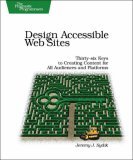If you own Adobe’s CS3 suite, Acrobat 8 Professional was bundled with the product. To buy it separately costs $449, but if you own an older version of the full Acrobat software, you can upgrade for $159. If you are interested in making your PDFs capable of use by screenreaders or small screens where the content must reflow to fit the screen, you need to use a structured document with tags added. Tags can only be added to a document with a full version of Acrobat, the Adobe Reader isn’t capable of doing this.
I’m using Acrobat 8 Professional to demo these steps. Older versions of the full Acrobat software can also tag documents.
 Open the PDF in Acrobat. You can tell if there are any tags already in the file by looking at the tags sidebar. In this example, there are no tags yet.
Open the PDF in Acrobat. You can tell if there are any tags already in the file by looking at the tags sidebar. In this example, there are no tags yet.
Use the Acrobat menu to add tags to your document.

In the Advanced menu, select Accessibility > Add Tags to Document.

The first screen that opens in the tags sidebar is a Recognition Report, which points out some of the missing accessibility information. Take a good look at what you’re missing here. You’ll need to address each item to make the PDF document usable and accessible for the small screen and screen readers.. Then select the tag icon on the far left side of the sidebar to move on to the tags category.

The complete list of tags and figures are given in the tags sidebar. Each one can be individually opened to examine.

To make changes in Figures, first highlight the figure you want to edit in the document window. It will be highlighted in the tags panel. Use right-click or ctrl-click to select the Properties menu for the item.

The Touch Up Properties dialog opens. Here you can add alt text and other accessiblility features.

Selecting any tag in the tag sidebar and going to the tag’s properties will allow you to change any inappropriately labeled tags.
When you save and close the document, the Recognition Report will disappear, but you will still have access to the Tags sidebar when you reopen the document. If you want the information, you can run various accessibility reports using the Advanced menu.
If possible, get someone with a PDA or screen reader to check your file for problems.
 Open the PDF in Acrobat. You can tell if there are any tags already in the file by looking at the tags sidebar. In this example, there are no tags yet.
Open the PDF in Acrobat. You can tell if there are any tags already in the file by looking at the tags sidebar. In this example, there are no tags yet.





